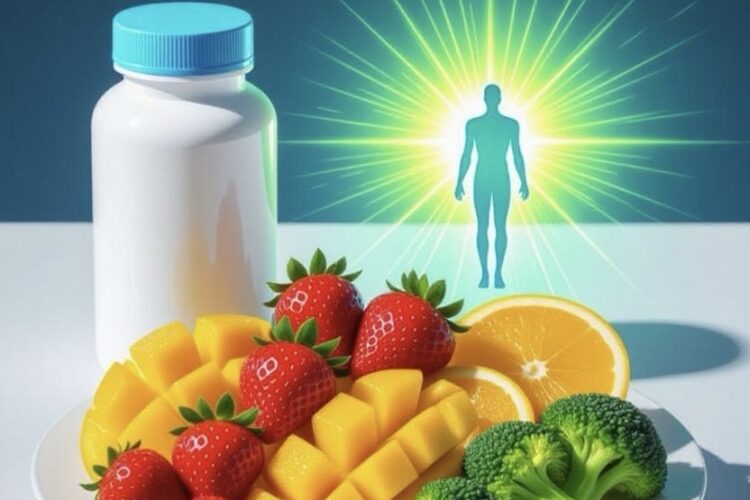Bioavailability determines how well your body absorbs nutrients, vitamins, minerals, and bioactive compounds from foods and supplements, boosting their health benefits. It shapes the nutritional value of micronutrients like iron and macronutrients like proteins, optimized by proper intake. Pharmacokinetics measures it via total exposure (AUC), peak concentration (Cmax), time to peak (Tmax), and half-life, assessing bioequivalence. Absorption relies on solubility and permeability; lipid-soluble vitamins pair with fats, while water-soluble ones use transporters. First-pass metabolism lowers bioavailability, but bioenhancers like piperine improve it, unlike inhibitors like phytates. Cooking and fermentation enhance mineral uptake, fortification adds nutrients, but overprocessing harms vitamins. Advanced supplement formulations like liposomes improve absorption of compounds like curcumin. Drug-nutrient interactions, like antacids reducing iron, require timed intake. Optimizing bioavailability via bioenhancers and bioequivalent supplements supports immunity and vitality.
Long Version
Understanding Bioavailability: The Key to Maximizing Nutrient Absorption from Foods and Supplements
Bioavailability represents the proportion of ingested nutrients, vitamins, minerals, or bioactive compounds that are absorbed and utilized by the body, directly influencing their efficacy and health benefits. In the context of diet and supplements, bioavailability determines how effectively micronutrients and macronutrients from food sources or dietary supplements contribute to metabolism, nutritional value, and overall well-being. While macronutrients like proteins and carbohydrates often exhibit high bioavailability due to efficient digestion, micronutrients such as iron or vitamin D can vary widely, affected by dietary factors and individual physiology. This concept is crucial for optimizing intake and dosage, ensuring that supplements and nutraceuticals deliver tangible benefits without excess consumption.
Measuring Bioavailability: Pharmacokinetic Insights
Pharmacokinetics provides the framework for quantifying bioavailability through key parameters like area under the curve (AUC), peak plasma concentration (Cmax), time to peak concentration (Tmax), and half-life. AUC measures the total exposure to a nutrient over time, reflecting absolute bioavailability—the fraction reaching systemic circulation—or relative bioavailability when comparing formulations. Cmax indicates the highest concentration achieved, while Tmax shows how quickly it occurs, and half-life reveals the duration of action before elimination. These metrics are derived from plasma concentration-time curves, helping assess bioequivalence between supplements or food-derived nutrients. For instance, algorithms predict bioavailability for various nutrients, though not all have standardized models, emphasizing the need for precise testing in human studies.
Factors Influencing Absorption and Digestion
Absorption, the process by which nutrients enter the bloodstream from the gastrointestinal tract, is modulated by solubility, permeability, and the Biopharmaceutics Classification System (BCS), which categorizes compounds based on these properties. Lipid-soluble vitamins like A and E dissolve in fats for easier uptake, whereas water-soluble ones like B vitamins rely on transporters such as P-glycoprotein or SLC transporters. Digestion breaks down food matrices, but first-pass metabolism in the liver can reduce bioavailability by metabolizing nutrients via CYP enzymes like CYP3A4 before they reach circulation. Enterohepatic circulation, where compounds are reabsorbed after biliary excretion, can extend half-life and enhance overall availability. Patient-specific factors, including age, genetic phenotype, or disorders like malabsorption syndromes, further impact these processes.
Metabolism integrates absorbed nutrients into bodily functions, but inhibitors like phytates, oxalates, and tannins in plant-based foods bind minerals, reducing their dissolution rate and permeability. Conversely, bioenhancers such as piperine from black pepper or quercetin from onions inhibit CYP enzymes or transporters, boosting absorption of bioactive compounds. Food matrix effects—the interactions within a meal’s structure—play a pivotal role; for example, fats enhance lipid-soluble nutrient uptake, while proteins may stabilize or hinder others.
Processing Effects and Food Sources
Processing effects, including cooking, fermentation, or fortification, significantly alter bioavailability. Cooking can break down inhibitors like phytates in grains, improving mineral absorption, while fermentation in yogurt enhances probiotic and calcium bioavailability through microbial action. Fortification adds nutrients to foods, like iron in cereals, but the food matrix must support their release for optimal efficacy. Natural food sources often provide superior bioavailability due to synergistic compounds; for instance, vitamin C in citrus boosts iron from spinach by countering inhibitors. However, overprocessing may degrade heat-sensitive vitamins, reducing nutritional value.
Advanced Formulations for Supplements
To overcome low inherent bioavailability, supplement formulations incorporate excipients, liposomes, nanoparticles, encapsulation, or micronization. Excipients like emulsifiers improve solubility in self-emulsifying drug delivery systems (SEDDS), enhancing dissolution rate for poorly soluble nutraceuticals. Liposomal encapsulation protects sensitive compounds from digestion, targeting release in the intestines for higher AUC and Cmax. Micronization reduces particle size, accelerating absorption, while nanoparticles facilitate permeability across barriers. These strategies are vital for nutraceuticals, ensuring bioactive compounds like curcumin achieve therapeutic levels despite poor natural bioavailability.
Interactions: Drug-Nutrient and Food-Drug Dynamics
Drug-nutrient interactions and food-drug interactions can profoundly affect bioavailability. For example, antacids raise stomach pH, impairing digestion and reducing manganese or iron absorption from supplements. Grapefruit juice inhibits CYP3A4, increasing bioavailability of certain drugs but potentially causing toxicity. Conversely, high-fiber meals may bind medications, decreasing their absorption. In nutraceuticals, these interactions highlight the need for timing intake—separating supplements from meals or drugs to avoid reduced efficacy. Fortified foods must account for such dynamics to maintain intended health benefits.
Practical Implications for Health and Diet
Optimizing bioavailability enhances health benefits, from immune support via vitamin C to bone health through calcium and vitamin D. Dietary factors like balanced meals with bioenhancers can amplify nutrient uptake, reducing reliance on high dosages that risk side effects. For supplements, choosing bioequivalent forms ensures consistent efficacy, particularly for those with malabsorption issues. Ultimately, understanding these elements empowers informed choices, transforming diet and supplementation into precise tools for sustained vitality.
Hashtags For Social Media
#Bioavailability #NutrientAbsorption #HealthAndWellness #SupplementTips #NutritionFacts #HealthyEating #VitaminAbsorption #BioactiveCompounds #Nutraceuticals #FoodScience #HealthyLiving #DietHacks #NutrientBoost #WellnessJourney #HealthOptimization #SuperfoodBenefits #Bioenhancers #GutHealth #NutritionTips #SupplementGuide #FoodMatrix #HealthyDiet #VitaminPower #MineralAbsorption #HealthGoals #WellnessHacks #NutrientUptake #BioavailabilityBoost #HealthTrends #NutritionScience
Related Questions, Words, Phrases
what is bioavailability | how does bioavailability work | why is bioavailability important | what affects nutrient absorption | how to improve supplement bioavailability | bioavailability of vitamins | what are bioenhancers | how does cooking affect nutrient bioavailability | role of food matrix in absorption | what is pharmacokinetics in nutrition | how to measure bioavailability | what is absolute bioavailability | relative bioavailability explained | how do lipids affect vitamin absorption | water-soluble vs lipid-soluble vitamins | what reduces nutrient bioavailability | impact of phytates on minerals | how piperine boosts bioavailability | enterohepatic circulation and nutrients | first-pass metabolism effects | supplement formulations for absorption | liposomes in supplements | nanoparticles in nutraceuticals | how fortification impacts bioavailability | drug-nutrient interactions | food-drug interaction effects | how to time supplement intake | best foods for iron absorption | vitamin c and iron synergy | curcumin bioavailability solutions | how fermentation improves nutrients | overprocessing and vitamin loss | bioequivalence in supplements | bioavailability for malabsorption issues | how to optimize nutrient uptake






